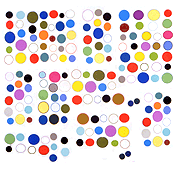Rhizome.org's Community Manager Zachary Kaplan has brought some needed zip to the website with a series of daily posts linking to and discussing various web content he is following. Sometimes Rhizome's editor Michael Conner makes contributions. How often does Conner weigh in, and in what proportion to Kaplan's blurbs? What types of things are they covering? Unfortunately I can't tell you, or I can tell you only in the most vague and general way, because they delete the posts the next day.
Kaplan says the content isn't lost -- he is planning to have a "best-of" post each month -- but the record that's created is entirely at his (or Rhizome's) discretion.
In a way, this solves a problem Rhizome has always had: is it a museum, being studiously neutral and objective in picking the most important "internet art," or is it a magazine, with a feisty and opinionated voice about what people are doing online (whether art or not)?
Kaplan's posts give us the pleasures of the latter but regrettably throw out the baby of a permanent record with the bathwater of studied faux-neutrality. Why should a record be treasured? It's a way to keep score -- one of the few honors for a so-called internet artist. Also it keeps the writers honest. If you think your words might trip you up a few years later you write them more carefully.
Below is an example of some of Kaplan's writing, from the Friday, August 22, 2014 Rhizome Today post. By Monday it will be gone. This sucks for Ryder Ripps, whose project Kaplan is discussing. Maybe Ripps will make the monthly best-of, maybe he won't. Do readers get a say in this? Maybe, or maybe not. Comments are deleted along with the daily posts (I tried a few days back). You can always email, or hit up the Rhizomers on commercial social media channels.
Instagram Corny-Core
Ryder Ripps is thinking about Instagram's "mawkishly sentimental tone to everyday common things," a heavily filtered, hypermoody selfie-lifestyle confluence. He takes Adrianne Ho's Instagram account as its apotheosis, and it's no coincidence that Ho's is a sponsored feed, tied to the clothes she's given to model.I've been aware of a profusion of variously branded content on Instagram for a while now, a result of friends working in the lifestyle publishing world — food, in particular, is a good way to see how this, pardon the pun, sausage is made. Brand diffusion on Instagram takes different forms. There is that which is obviously sponsored, as in paid (to the social network) ads that pop into feeds, or clearly demarcated sponsored 'editorial content' with brand @ing on 'independent' accounts. There is also a shadow economy of soft sponsorship by way of freebies then imaged by trusted native accounts. What Ryder is thinking about is what I see on a daily basis.
One reason that Instagram is so fertile for both styles of advertising is that its discoverability is so horrible — like its owner, Facebook, Instagram closes your feed in on itself, with very little invitation to explore different Instagram experiences, different Instagram worlds, different people. The Explore tab used to filter in all sorts of weird images that were trending, but as of late last year, it now displays things your friends are liking. Vine — wonderful, amazing Vine — in contrast, is all about discoverability, randomness, and blur. One powerful mechanism here is the ReVine, which allows anyone to republish anything. Instagram instead is personal, owned, and hermetic. A closed world where one can fully know and expect another's audience is a world built for advertising.
Does Ripps' project deserve a permanent, implied thumbs-up validation as important internet art on Rhizome's front page, or is it half-amusing, ephemeral, daily link fodder? Kaplan hedges his bets here. Ripps' slide show on Tumblr, On Ho, commenting on the closed loop style of image evaluation of the popular Facebook-owned Instagram application/database/website/thing, would seem to have the right blend of front page critique and cheek. But perhaps it falls short of that, and is only a curmudgeonly rant with elements of dashed-off creativity (Ripps's smartphone defacements of Instagram images and painted versions of the defacements that may or may not be done by Jeff Koons' assistants -- more on those paintings later). Also, Kaplan wants to get in his own point of view, which is that Vine (a rival application/database/website/thing owned by Twitter) is a better, less hermetic, less commercial experience (and therefore more innately art-like?) than the product Ripps is critiquing. As a Rhizome editorializer, this is within bounds, as a curator, it's probably overstepping. Imagine a museum wall-label that suddenly goes off on an artist for deconstructing the wrong thing. Whatever problems this raises, rest assured they will be not be discussed, because by the time you've wrapped your mind around them the post will be gone and we will be on to something else.
